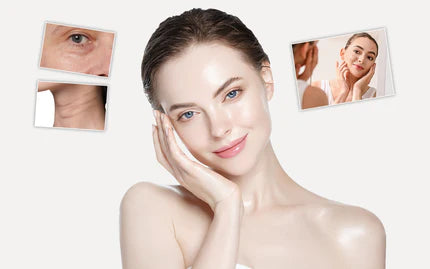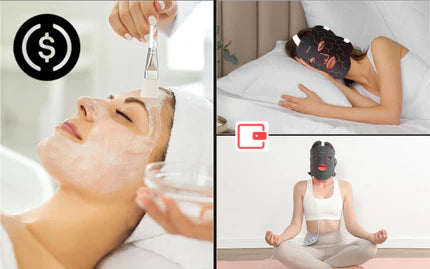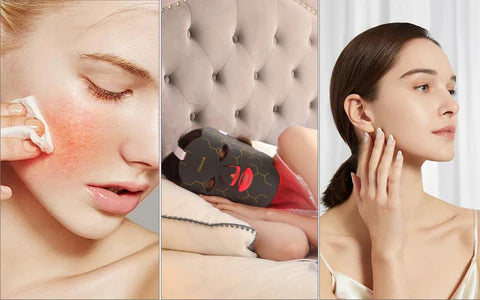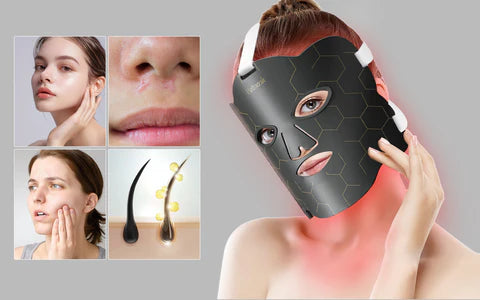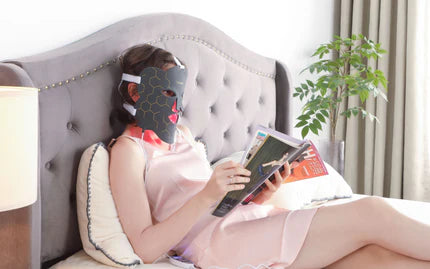Taking care of your skin is more than just looking good; it’s about feeling good and building confidence. In this light, Red Light Therapy (RLT) stands out as a simple, yet effective tool in your skincare arsenal. Our article will guide you through what RLT is, its benefits, and how you can use it at home. We’ll also compare RLT to other skin care treatments and clear up any common questions you might have. Presented in clear, everyday language, this piece aims to provide an easy-to-follow overview of RLT, giving you the knowledge to make informed choices about this popular skin health method.
What is Red Light Therapy?
Red Light Therapy (RLT) is a treatment that uses red, low-level wavelengths of light to treat skin issues, such as wrinkles, scars, and persistent wounds, among other conditions. Unlike more invasive procedures that cut or scrape the skin, or laser therapy which can cause burns, RLT is painless and non-destructive, offering a soothing solution for skin rejuvenation.

The Scientific Evolution of RLT in Skincare
The progress of RLT from being an experimental science to becoming a reliable skincare solution is quite remarkable. It came from space where scientists discovered its potential to grow plants and heal injuries in astronauts. In dermatology, RLT has become increasingly sophisticated through extensive research on its efficacy, thereby evolving into an advanced form of anti-aging therapy and skin repair recognized by professionals across the globe.
Mechanism of Action on a Cellular Level
At the cellular level, Red Light Therapy (RLT) works by:
- Enhancing Mitochondrial Function: RLT boosts mitochondria in skin cells, increasing their energy output and leading to healthier cell function.
- Increasing ATP Production: With more active mitochondria, cells produce more ATP, the energy that powers cellular repair and rejuvenation processes.
- Stimulating Collagen and Elastin: By activating fibroblasts, RLT promotes the production of collagen and elastin, essential for skin firmness and elasticity.
Through the enhancement of mitochondrial function, increase in ATP production, and promotion of collagen and elastin, RLT offers a multipronged approach to improve skin health at the source—the cells themselves.
What Are the Benefits of Red Light Therapy for Skin?
1. Enhanced Complexion and Texture
One of the most noticeable effects that come with regular use of RLT is an improved complexion. Users have reported a healthier radiance probably due to better blood flow as well as enhanced cell quality. Additionally, over time RLT stimulates new cell growth while repairing damaged ones leading to smoother skin texture.

2. Reduction of Fine Lines and Wrinkles
As we age, our skin produces less collagen, leading to the formation of wrinkles. Thanks to RLT’s ability to promote collagen and elastin production, it can significantly reduce these signs of aging. Consistent use of RLT has been associated with fewer fine lines and wrinkles, as well as improved skin firmness.
3. Healing Acceleration and Reduced Inflammation
Besides giving an aesthetic appeal to the users’ appearance, RLT has some healing properties too. This is especially useful in instances such as injuries, post-surgical wounds, or even acne. Additionally, the anti-inflammatory attributes of RLT help in managing swelling and redness especially prevalent among people with eczema or rosacea conditions.
4. Personal Testimonials and Expert Opinions
Beyond clinical trials, personal stories add weight to the effectiveness of RLT. Skincare forums and social media are rich with before-and-after photos showcasing real results. Additionally, dermatologists and skincare experts often advocate for RLT as part of a comprehensive approach to skin health, further validating its place in the skincare industry.
How to Use Red Light Therapy for Skin Rejuvenation
1. Types of RLT Devices
When it comes to choosing a Red Light Therapy device, you have two main options: professional treatments or at-home devices. Professional treatments are often more powerful and can provide comprehensive coverage in a clinical setting. On the other hand, at-home devices offer convenience and can be a cost-effective alternative, allowing you to integrate RLT into your daily routine.
- In-Office Professional Systems: These systems are typically found in dermatologists’ offices or specialized skin clinics. They tend to use higher intensity light and cover a larger area of the skin at once, often leading to quicker results.
- At-Home RLT Devices: Home-use devices come in various forms like red light therapy masks, handheld wands, and panels. They are designed for ease of use and generally have lower light intensity compared to professional systems. When selecting an at-home device, look for FDA approval to ensure safety and efficacy.
2. Step-by-Step Guide to Using RLT
Using RLT is straightforward, but it’s important to follow a few steps to get the best results:
- Cleanse Your Skin: Start with clean skin, free from makeup and skincare products, to allow the red light to penetrate effectively.
- Use Safety Gear if Recommended: Some devices may come with safety goggles to protect your eyes from the bright light, so use them if they’re included.However, the Hottoerak Red Light Therapy Mask doesn't require you to wear goggles as it provides targeted treatment for specific facial areas. Additionally, for those looking to treat the neck and upper chest, we have specialized products available.
- Position the Device: Whether you’re using a handheld unit or a larger panel, position the device according to the manufacturer’s instructions, usually keeping it a few inches away from your skin.
- Set the Timer: RLT sessions typically last between 10 to 20 minutes. Follow the guidelines provided by your device.
- Relax and Enjoy: During the treatment, you can simply relax. You should feel a gentle, warming sensation as the light bathes your skin.

3. How Often and How Long Should You Use Red Light Therapy?
The optimal frequency of RLT can vary depending on the specific device and the condition being treated. A common recommendation for at-home devices is 5 to 10 minutes per treatment area, 3 to 5 times a week. For professional treatments, a dermatologist might suggest a schedule based on the intensity of the light and the nature of the skin issue.
4. Safety Considerations and Potential Side Effects
RLT is generally considered safe, but like any treatment, there are considerations and potential side effects to keep in mind:
- Overuse: Avoid the temptation to overdo it; excessive use can potentially lead to skin redness or irritation.
- Eye Protection: The intense light can be harmful to your eyes, so proper eye protection is crucial when using RLT without built-in safeguards.
- Follow Instructions: Always use the device as directed, and consult with a healthcare provider before starting treatment if you have concerns, especially if you have existing health issues or are pregnant.
How to Integrate Red Light Therapy into Your Daily Skincare
1. Combining RLT with Everyday Skincare
For maximum results from Red Light Therapy (RLT), it is good to incorporate it into your daily skin care practices. Make sure you are doing the basics: washing your face, moisturizing, and do not forget to apply sunscreen before stepping outside. Incorporate antioxidants like vitamin C to possibly boost RLT’s effectiveness. If your RLT session is during the day and you plan to step outside afterward, don’t forget to apply sunscreen after the session to protect your skin from UV damage.
2. Tips for Better RLT Results
- Stick to a Routine: To achieve the best results from RLT, it’s important to use it regularly. Setting a specific time for your sessions can help make it part of your everyday skincare regimen.
- Allow Time for Results: The positive changes in your complexion under RLT do not occur instantaneously; they manifest after some weeks of uninterrupted treatment hence be patient about that.
- Start with a Clean Face: To allow light to penetrate fully and work effectively, make-up, creams or sunscreens should not be on your skin before you switch on the red light therapy device.

3. Choosing Skincare Products to Use with RLT
Be selective about what skincare products can go along with your RLT. Look out for something gentle; something that nourishes easily think about what’s good for the skin. Avoid any such harsh components like retinoids or tough scrubs which could irritate the skin especially when used right before or after an RLT session because if this happens one may wish to think of subsequent product usage’ peptides,’ ‘growth factors’ or ‘ceramides.’
4. Being Realistic About What RLT Can Do
Although Red Light Therapy (RLT) has numerous benefits for the skin, it is not magic wand stuff here. How well it works often depends on various factors e.g., age, type of skin, and specific skin concerns. So keep your expectations realistic—it is all about long-term care for your skin rather than a quick fix.
Red Light Therapy vs. Other Skin Rejuvenation Methods
Comparing RLT to Chemical Peels
Chemical peels involve applying a solution to the skin that exfoliates it over time until new, smoother skin is revealed underneath. These produce good results for many but they can be unpleasant and must heal in time. In contrast, RLT offers a gentler approach; it doesn’t remove layers of skin or require recovery time, making it suitable for those with sensitive skin or busy lifestyles.
RLT and Laser Treatments: What’s the Difference?
Laser treatments work by concentrating light beams on the affected areas to either take off one layer of the skin at a time or stimulate collagen production in such localized parts. Despite their success rates such methods often come with side effects like inflammation, redness or scarring risks. RLT however, has fewer known ill effects as compared to laser treatment resulting into more general benefits but may take longer before any noticeable change takes place as opposed to instant results from laser therapy.
Microneedling vs. RLT
The procedure of microneedling involves the utilization of needles which are usually fine in order to make minuscule punctures on the skin surface. This helps to reduce scars and wrinkles on the skin, thus making it smoother. Its popularity is evident; however, it can cause irritation while still requiring a sterile environment so as to prevent infections. Conversely, RLT is not invasive at all and has no risk involved with this comforting choice which one may opt for while doing it at home.
Final Thoughts on Red Light Therapy for Skin Health
Red Light Therapy stands out as a gentle yet powerful ally in the quest for healthier skin, offering a way to rejuvenate your complexion non-invasively. It works its magic by smoothing out textures and easing away the telltale signs of aging, all while speeding up the body’s natural healing processes and curtailing inflammation. When RLT is woven into a broader tapestry of consistent skincare practices and healthy life choices, the result is a more vibrant, youthful appearance. Safe, scientifically validated, and easy to incorporate into daily routines, Rlt proves to be more than just a skincare trend—it’s a holistic approach to maintaining the skin’s natural glow, ensuring that your outer radiance mirrors inner health.Read more: benefits and considerations of red light therapy.


